Page 1283 of 1903
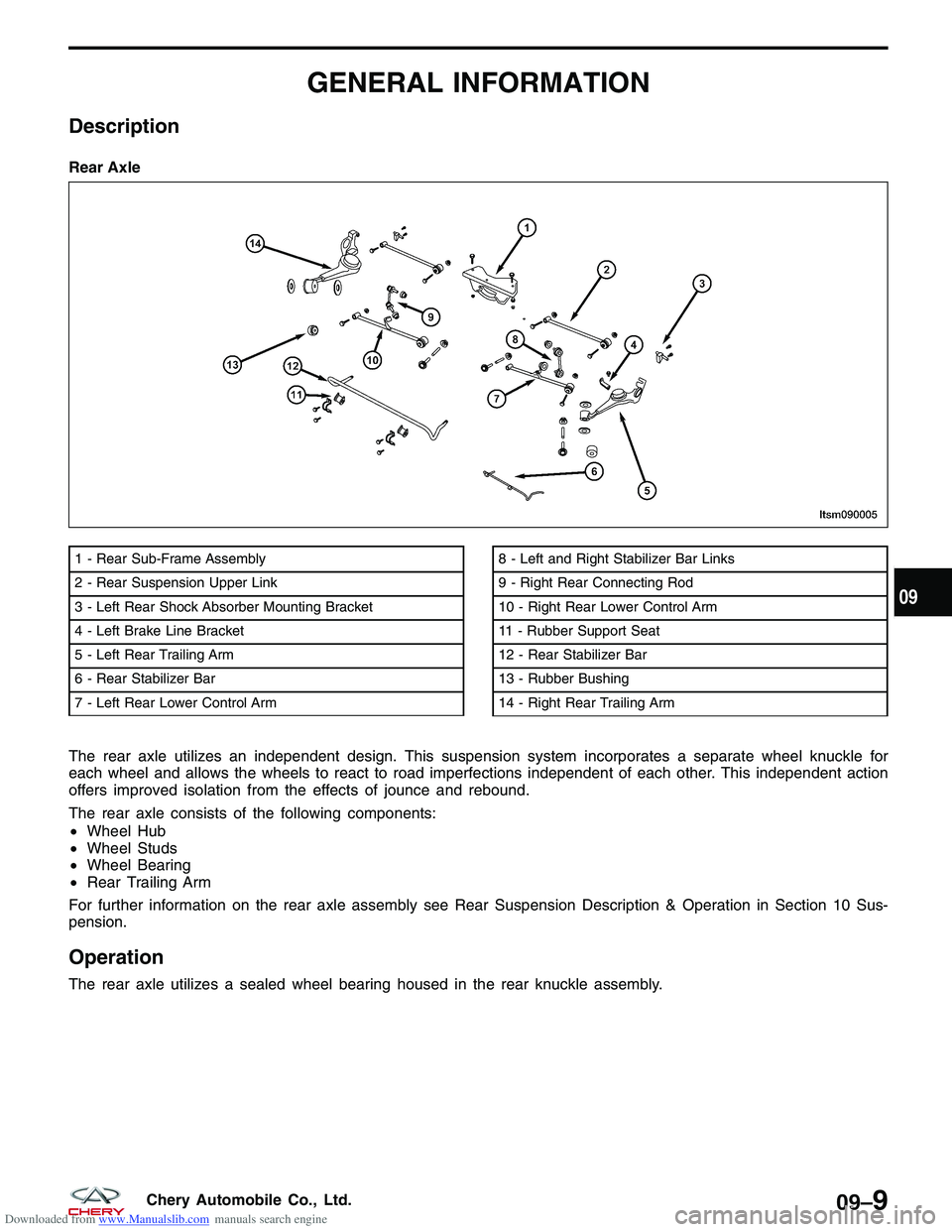
Downloaded from www.Manualslib.com manuals search engine GENERAL INFORMATION
Description
The rear axle utilizes an independent design. This suspension system incorporates a separate wheel knuckle for
each wheel and allows the wheels to react to road imperfections independent of each other. This independent action
offers improved isolation from the effects of jounce and rebound.
The rear axle consists of the following components:
•Wheel Hub
• Wheel Studs
• Wheel Bearing
• Rear Trailing Arm
For further information on the rear axle assembly see Rear Suspension Description & Operation in Section 10 Sus-
pension.
Operation
The rear axle utilizes a sealed wheel bearing housed in the rear knuckle assembly. Rear Axle
1 - Rear Sub-Frame Assembly
2 - Rear Suspension Upper Link
3 - Left Rear Shock Absorber Mounting Bracket
4 - Left Brake Line Bracket
5 - Left Rear Trailing Arm
6 - Rear Stabilizer Bar
7 - Left Rear Lower Control Arm8 - Left and Right Stabilizer Bar Links
9 - Right Rear Connecting Rod
10 - Right Rear Lower Control Arm
11 - Rubber Support Seat
12 - Rear Stabilizer Bar
13 - Rubber Bushing
14 - Right Rear Trailing Arm
LTSM090005
09
09–9Chery Automobile Co., Ltd.
Page 1284 of 1903
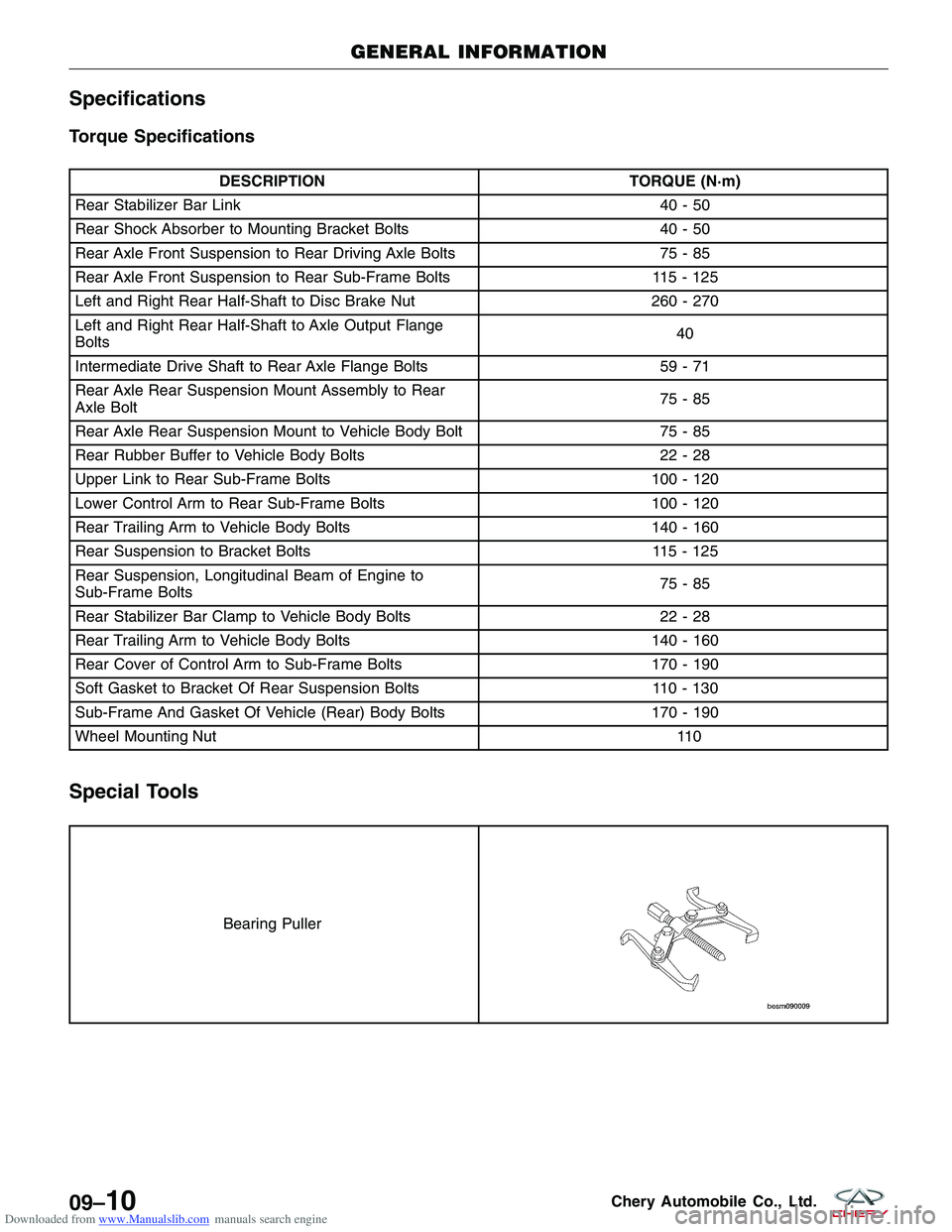
Downloaded from www.Manualslib.com manuals search engine Specifications
Torque Specifications
DESCRIPTIONTORQUE (N·m)
Rear Stabilizer Bar Link 40 - 50
Rear Shock Absorber to Mounting Bracket Bolts 40 - 50
Rear Axle Front Suspension to Rear Driving Axle Bolts 75 - 85
Rear Axle Front Suspension to Rear Sub-Frame Bolts 115 - 125
Left and Right Rear Half-Shaft to Disc Brake Nut 260 - 270
Left and Right Rear Half-Shaft to Axle Output Flange
Bolts 40
Intermediate Drive Shaft to Rear Axle Flange Bolts 59 - 71
Rear Axle Rear Suspension Mount Assembly to Rear
Axle Bolt 75-85
Rear Axle Rear Suspension Mount to Vehicle Body Bolt 75 - 85
Rear Rubber Buffer to Vehicle Body Bolts 22 - 28
Upper Link to Rear Sub-Frame Bolts 100 - 120
Lower Control Arm to Rear Sub-Frame Bolts 100 - 120
Rear Trailing Arm to Vehicle Body Bolts 140 - 160
Rear Suspension to Bracket Bolts 115 - 125
Rear Suspension, Longitudinal Beam of Engine to
Sub-Frame Bolts 75-85
Rear Stabilizer Bar Clamp to Vehicle Body Bolts 22 - 28
Rear Trailing Arm to Vehicle Body Bolts 140 - 160
Rear Cover of Control Arm to Sub-Frame Bolts 170 - 190
Soft Gasket to Bracket Of Rear Suspension Bolts 110 - 130
Sub-Frame And Gasket Of Vehicle (Rear) Body Bolts 170 - 190
Wheel Mounting Nut \
\
11 0
Special Tools
Bearing Puller
GENERAL INFORMATION
09–10Chery Automobile Co., Ltd.
Page 1286 of 1903
Downloaded from www.Manualslib.com manuals search engine ON-VEHICLE SERVICE
Rear Hub and Bearing
Removal & Installation
1. Raise and support the vehicle.
2. Remove the wheel mounting nuts and the tire and wheel assembly.(Tighten: Wheel mounting nuts to 110 N·m)
3. Disconnect the ABS wheel speed sensor electrical connector.
4. While an assistant applies the brakes (to keep the hub from rotating), remove the hub nut from the axle half shaft.
(Tighten: Hub nut to 135 N·m)
5. Remove the rear brake rotor (See Rear Brake Rotor Removal & Installation in Section 12 Brakes).
6. Remove the hub and bearing mounting nuts (1). (Tighten: Hub and bearing mounting nuts to 65
N·m)
7. Take out the rear hub and bearing.
8. Installation is in the reverse order of the removal.
LTSM090001
09–12Chery Automobile Co., Ltd.
Page 1292 of 1903
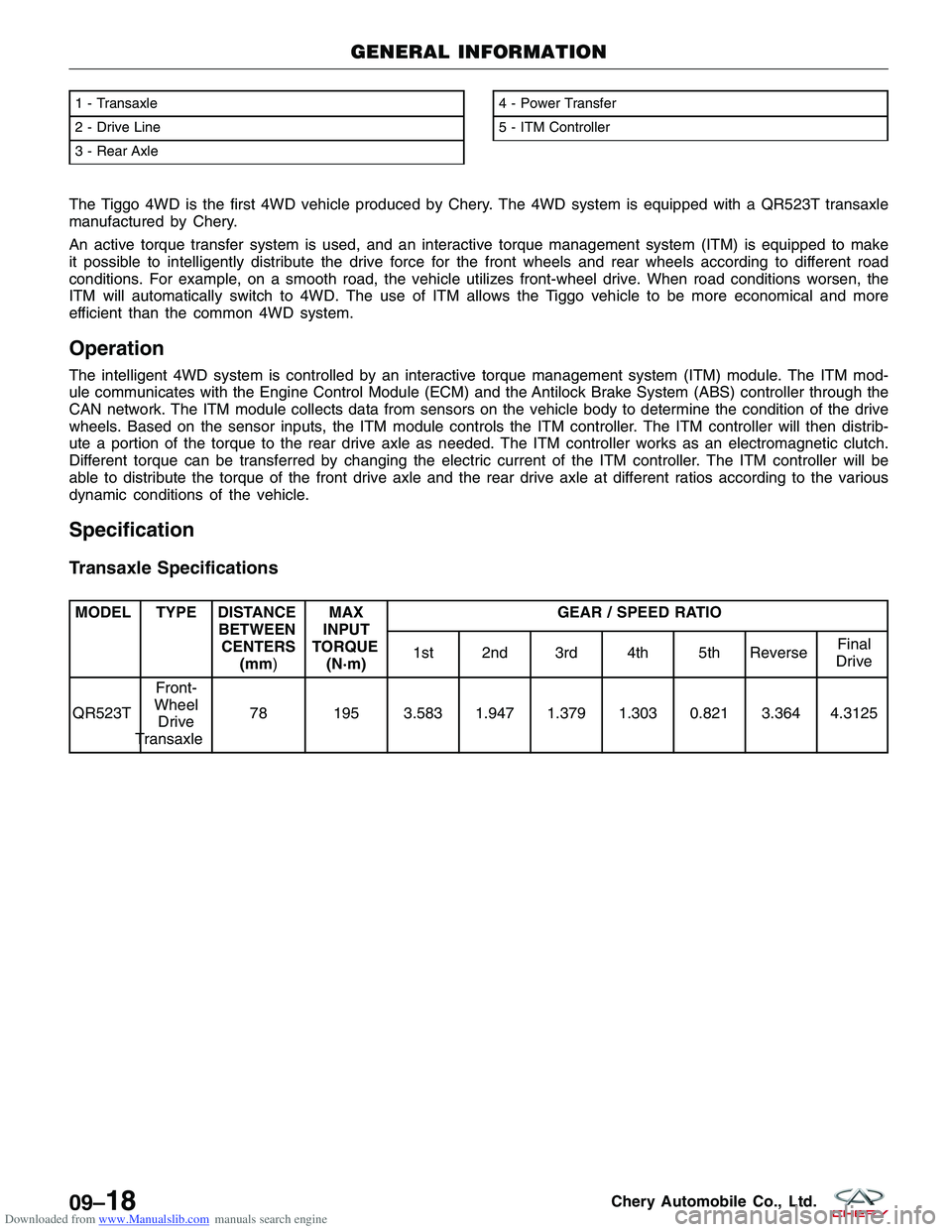
Downloaded from www.Manualslib.com manuals search engine The Tiggo 4WD is the first 4WD vehicle produced by Chery. The 4WD system is equipped with a QR523T transaxle
manufactured by Chery.
An active torque transfer system is used, and an interactive torque management system (ITM) is equipped to make
it possible to intelligently distribute the drive force for the front wheels and rear wheels according to different road
conditions. For example, on a smooth road, the vehicle utilizes front-wheel drive. When road conditions worsen, the
ITM will automatically switch to 4WD. The use of ITM allows the Tiggo vehicle to be more economical and more
efficient than the common 4WD system.
Operation
The intelligent 4WD system is controlled by an interactive torque management system (ITM) module. The ITM mod-
ule communicates with the Engine Control Module (ECM) and the Antilock Brake System (ABS) controller through the
CAN network. The ITM module collects data from sensors on the vehicle body to determine the condition of the drive
wheels. Based on the sensor inputs, the ITM module controls the ITM controller. The ITM controller will then distrib-
ute a portion of the torque to the rear drive axle as needed. The ITM controller works as an electromagnetic clutch.
Different torque can be transferred by changing the electric current of the ITM controller. The ITM controller will be
able to distribute the torque of the front drive axle and the rear drive axle at different ratios according to the various
dynamic conditions of the vehicle.
Specification
Transaxle Specifications
MODEL TYPE DISTANCEBETWEENCENTERS (mm) MAX
INPUT
TORQUE (N·m) GEAR / SPEED RATIO
1st 2nd 3rd 4th 5th Reverse Final
Drive
QR523T Front-
Wheel Drive
Transaxle 78 195 3.583 1.947 1.379 1.303 0.821 3.364 4.3125
1 - Transaxle
2 - Drive Line
3 - Rear Axle4 - Power Transfer
5 - ITM Controller
GENERAL INFORMATION
LTSM160027
09–18Chery Automobile Co., Ltd.
Page 1297 of 1903
Downloaded from www.Manualslib.com manuals search engine Interactive Torque Management (ITM) Control Module
Description
The ITM control module is located under the driver seat.
Operation
The ITM control module collects signals from the Engine Control Module (ECM) and Antilock Brake System (ABS)
controller, judges the vehicle driving state, controls the working electric current of the ITM controller and distributes
the torque of the front axle and the rear axle intelligently according to such signals.
Removal & Installation
1. Disconnect the negative battery cable.
2. Adjust the left front seat fully backward.
3. Remove the ITM control module mounting bolts.
4. Remove the ITM control module electrical connec-tor.
5. Remove the ITM control module (1).
6. Installation is in the reverse order of removal.
ON-VEHICLE SERVICE
LTSM16002809
09–23Chery Automobile Co., Ltd.
Page 1305 of 1903
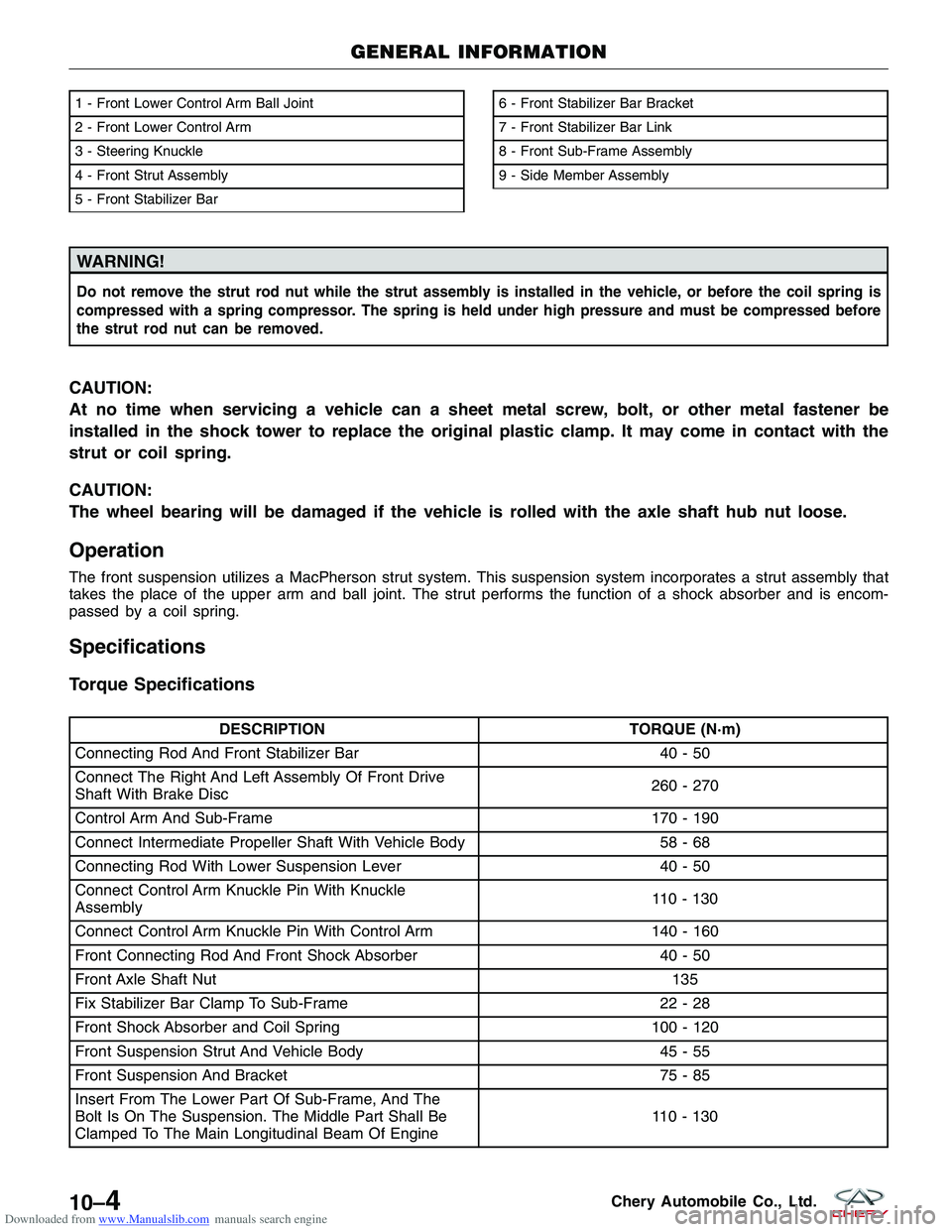
Downloaded from www.Manualslib.com manuals search engine WARNING!
Do not remove the strut rod nut while the strut assembly is installed in the vehicle, or before the coil spring is
compressed with a spring compressor. The spring is held under high pressure and must be compressed before
the strut rod nut can be removed.
CAUTION:
At no time when servicing a vehicle can a sheet metal screw, bolt, or other metal fastener be
installed in the shock tower to replace the original plastic clamp. It may come in contact with the
strut or coil spring.
CAUTION:
The wheel bearing will be damaged if the vehicle is rolled with the axle shaft hub nut loose.
Operation
The front suspension utilizes a MacPherson strut system. This suspension system incorporates a strut assembly that
takes the place of the upper arm and ball joint. The strut performs the function of a shock absorber and is encom-
passed by a coil spring.
Specifications
Torque Specifications
DESCRIPTIONTORQUE (N·m)
Connecting Rod And Front Stabilizer Bar 40 - 50
Connect The Right And Left Assembly Of Front Drive
Shaft With Brake Disc 260 - 270
Control Arm And Sub-Frame 170 - 190
Connect Intermediate Propeller Shaft With Vehicle Body 58 - 68
Connecting Rod With Lower Suspension Lever 40 - 50
Connect Control Arm Knuckle Pin With Knuckle
Assembly 110 - 130
Connect Control Arm Knuckle Pin With Control Arm 140 - 160
Front Connecting Rod And Front Shock Absorber 40 - 50
Front Axle Shaft Nut 135
Fix Stabilizer Bar Clamp To Sub-Frame 22 - 28
Front Shock Absorber and Coil Spring 100 - 120
Front Suspension Strut And Vehicle Body 45 - 55
Front Suspension And Bracket 75 - 85
Insert From The Lower Part Of Sub-Frame, And The
Bolt Is On The Suspension. The Middle Part Shall Be
Clamped To The Main Longitudinal Beam Of Engine 110 - 130
1 - Front Lower Control Arm Ball Joint
2 - Front Lower Control Arm
3 - Steering Knuckle
4 - Front Strut Assembly
5 - Front Stabilizer Bar6 - Front Stabilizer Bar Bracket
7 - Front Stabilizer Bar Link
8 - Front Sub-Frame Assembly
9 - Side Member Assembly
GENERAL INFORMATION
LTSM100008
10–4Chery Automobile Co., Ltd.
Page 1308 of 1903
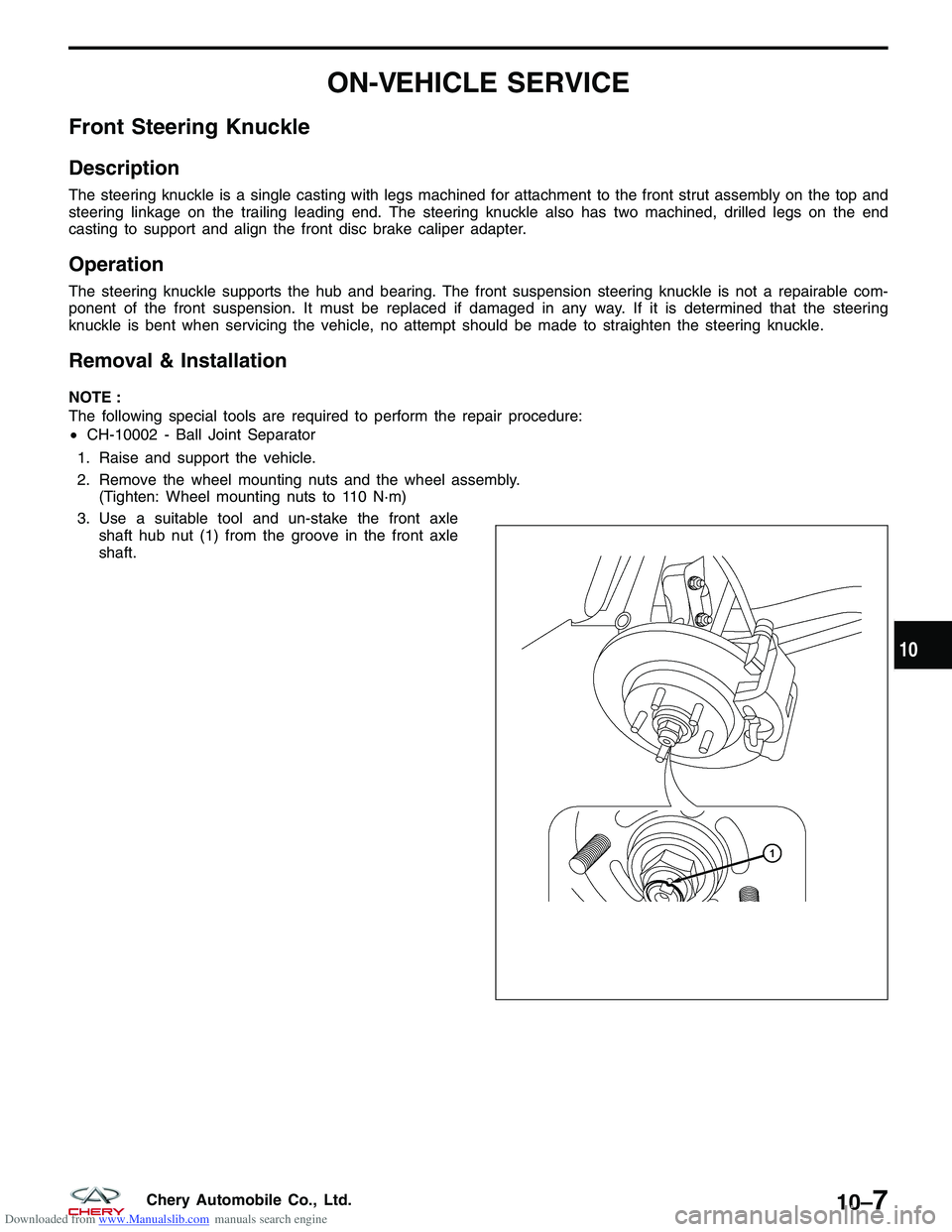
Downloaded from www.Manualslib.com manuals search engine ON-VEHICLE SERVICE
Front Steering Knuckle
Description
The steering knuckle is a single casting with legs machined for attachment to the front strut assembly on the top and
steering linkage on the trailing leading end. The steering knuckle also has two machined, drilled legs on the end
casting to support and align the front disc brake caliper adapter.
Operation
The steering knuckle supports the hub and bearing. The front suspension steering knuckle is not a repairable com-
ponent of the front suspension. It must be replaced if damaged in any way. If it is determined that the steering
knuckle is bent when servicing the vehicle, no attempt should be made to straighten the steering knuckle.
Removal & Installation
NOTE :
The following special tools are required to perform the repair procedure:
•CH-10002 - Ball Joint Separator
1. Raise and support the vehicle.
2. Remove the wheel mounting nuts and the wheel assembly. (Tighten: Wheel mounting nuts to 110 N·m)
3. Use a suitable tool and un-stake the front axle shaft hub nut (1) from the groove in the front axle
shaft.
??????
10
10–7Chery Automobile Co., Ltd.
Page 1309 of 1903
Downloaded from www.Manualslib.com manuals search engine 4. While a helper applies the brakes to keep the hubfrom rotating, remove the front axle shaft nut (1).
(Tighten: Front axle shaft nut to 135 N·m)
5. Access and remove the front brake rotor (See Front Brake Rotor Remove & Installation in Section 12 Brakes).
6. Remove the wheel speed sensor mounting bolt (1). (Tighten: Wheel speed sensor mounting bolt to 10
± 1 N·m)
7. Remove the wheel speed sensor and set it aside.
8. Remove the lower ball joint mounting nut (1) attaching the lower control arm to the knuckle.
(Tighten: Control arm to steering knuckle nut to
120 ± 10 N·m)
9. Remove the nut (1) attaching the outer tie rod end to the steering knuckle.
(Tighten: Outer tie rod end nut to 32 - 38 N·m)
ON-VEHICLE SERVICE
LTSM090006
LTSM100045
LTSM100006
LTSM110034
10–8Chery Automobile Co., Ltd.